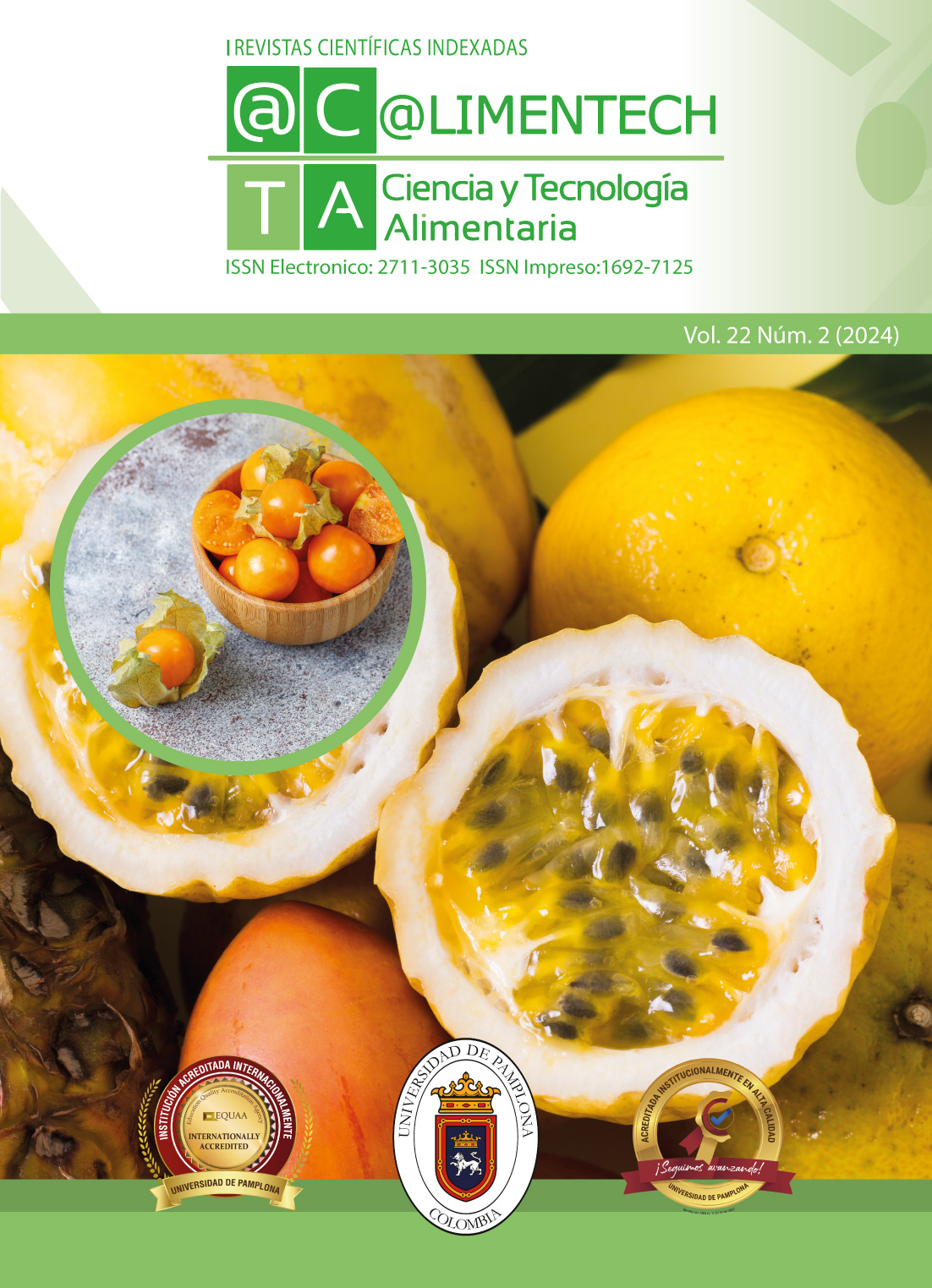Development And Optimization Of An Active Coating Using Response Surface Methodology To Extend The Shelf Life Of Guava (Psidium Guajava) In Post-Harvest Storage
DOI:
https://doi.org/10.24054/limentech.v22i2.3620Keywords:
edible coating, quality,, numerical análisis, Psidium guajavaAbstract
The coatings aim to primarily increase the shelf life of the food matrix they cover. In the following work, a response surface methodology was used with a Box-Behnken design to evaluate the effect of the materials (gellan gum, chitosan, and polysorbate 20) that make up the coating on the quality attributes of guava stored at 25°C and 70% relative humidity. The selected quality parameters were: weight loss (WL), total soluble solids (TSS), titratable acidity (TA), respiration rate (RR), and color change (AE) of the coated guava fruits. The results showed that the concentration of gellan gum, chitosan, and polysorbate 20 significantly influences (p<0.05) the response variables studied. The results suggest that increasing the concentrations of gellan gum and chitosan extends the quality attributes of guava fruits during post-harvest by reducing the values of WL, TSS, RR, and AE during storage. Furthermore, the second-order polynomial models adequately describe the behavior of the quality attributes of the coated guava. Consequently, the coating with gellan gum and chitosan has the potential to increase the post-harvest shelf life of guavas.
Downloads
References
Ali A., Muhammad M.T.M., Sijam K., Siddiqui Y. (2011). Effect of chitosan coatings on the physicochemical characteristics of Eksotika II papaya (Carica papaya L.) fruit during cold storage. Food Chemistry, 124(2), 620–626. https://doi.org/10.1016/j.foodchem.2010.06.085. DOI: https://doi.org/10.1016/j.foodchem.2010.06.085
Arango-González, Diana Carolina; Casas-Forero, Nidia. (2024). Aplicación de un recubrimiento comestible a base de goma guar para mejorar la tolerancia al frio de tomate chonto (Solanum Lycopersicum) durante el almacenamiento. Revista @limentech, Ciencia y Tecnología Alimentaria. ISSN Impreso 1692-7125 ISSN Electrónico 2711-3035. Volumen 22 N° 1. Pp: 192 - 210. https://doi.org/10.24054/limentech.v22i1.3151
Arroyo B.J., Bezerra A.C., Oliveira L.L., Arroyo S.J., de Melo E.A., Santos A.M.P. (2020). Antimicrobial active edible coating of alginate and chitosan add ZnO nanoparticles applied in guavas (Psidium guajava L.). Food Chemistry, 309, 125–566. https://doi.org/10.1016/j.foodchem.2019.125566 DOI: https://doi.org/10.1016/j.foodchem.2019.125566
Hanani Z.A.N., Soo K.L., Ibadullah W.Z.W., Radhiah S. (2023). Prolonging the shelf life of fresh-cut guava (Psidium guajaya L.) by coating with chitosan and cinnamon essential oil. Heliyon, 9(12), e22419. https://doi.org/10.1016/j.heliyon.2023.e22419 DOI: https://doi.org/10.1016/j.heliyon.2023.e22419
Hernandez-Muñoz P., Almenar E., Del Valle V., Velez D., Gavara R. (2008). Effect of chitosan coating combined with postharvest calcium treatment on strawberry (Fragaria ananassa) quality during refrigerated storage. Food Chemistry, 110, 428–435. https://doi.org/10.1016/j.foodchem.2008.02.020 DOI: https://doi.org/10.1016/j.foodchem.2008.02.020
Hong K., Xie J., Zhang L., Sun D., Gong D. (2012). Effects of chitosan coating on postharvest life and quality of guava (Psidium guajava L.) fruit during cold storage. Scientia Horticulturae, 144, 172–178. https://doi.org/10.1016/j.scienta.2012.07.002 DOI: https://doi.org/10.1016/j.scienta.2012.07.002
Khaliq G., Mohamed M.T.M., Ali A., Ding P., Ghazali H.M. (2015). Effect of gum arabic coating combined with calcium chloride on physico-chemical and qualitative properties of mango (Mangifera indica L.) fruit during low temperature storage. Scientia Horticulturae, 190, 187–194. https://doi.org/10.1016/j.scienta.2015.04.020 DOI: https://doi.org/10.1016/j.scienta.2015.04.020
Khalifa I., Barakat H., El-Mansy H.A., Soliman S.A. (2016). Enhancing the keeping quality of fresh strawberry using chitosan-incorporated olive processing wastes. Food Bioscience, 13, 69–75. https://doi.org/10.1016/j.fbio.2015.12.008 DOI: https://doi.org/10.1016/j.fbio.2015.12.008
Kumar M., Kapoor S., Dhumal S., Tkaczewska J., Changan S., Saurabh V., Bhuyan D.J. (2022). Guava seed (Psidium guajava L.): A low-volume, high-value by-product for human health and the food industry. Food Chemistry, 386, 132694. https://doi.org/10.1016/j.foodchem.2022.132694 DOI: https://doi.org/10.1016/j.foodchem.2022.132694
Navarro-Tarazaga M.L., Massa A., Pérez-Gago M.B. (2011). Effect of beeswax content on hydroxypropyl methylcellulose-based edible film properties and postharvest quality of coated plums (Cv. Angeleno). LWT - Food Science and Technology, 44(10), 2328–2334. https://doi.org/10.1016/j.lwt.2011.03.011 DOI: https://doi.org/10.1016/j.lwt.2011.03.011
Santos A.M.P., de Melo E.A. (2020). Application of edible biopolymer coatings to extend the storage life of fresh fruits and vegetables. Biopolymer Membranes and Films. Elsevier Inc. https://doi.org/10.1016/b978-0-12-818134-8.00020-1 DOI: https://doi.org/10.1016/B978-0-12-818134-8.00020-1
Santos T.M., de Souza F.M., Silva D.O., da Silveira M.R., de Miranda M.R., Lopes M.A., Azeredo M.C. (2018). Enhancing storage stability of guava with tannic acid-crosslinked zein coatings. Food Chemistry, 257, 252–258. https://doi.org/10.1016/j.foodchem.2018.03.021 DOI: https://doi.org/10.1016/j.foodchem.2018.03.021
Silva W.B., Silva G.M.C., Santana D.B., Salvador A.R., Medeiros D.B., Belghith I., Misobutsi G.P. (2018). Chitosan delays ripening and ROS production in guava (Psidium guajava L.) fruit. Food Chemistry, 242, 232–238. http://dx.doi.org/10.1016/j.foodchem.2017.09.052 DOI: https://doi.org/10.1016/j.foodchem.2017.09.052
Singh M., Saroj R., Kaur D. (2024). Optimized chitosan edible coating for guava and its characterization. Measurement: Food, 14, 100145. https://doi.org/10.1016/j.meafoo.2024.100145 DOI: https://doi.org/10.1016/j.meafoo.2024.100145
Zhao Y. (2018). Edible coatings for extending shelf-life of fresh produce during postharvest storage. In Reference module in food science (pp. 1–5). Elsevier. https://doi.org/10.1016/B978-0-08-100596-5.22262-2 DOI: https://doi.org/10.1016/B978-0-08-100596-5.22262-2
Downloads
Published
How to Cite
Issue
Section
License
Copyright (c) 2024 @limentech, Ciencia y Tecnología Alimentaria

This work is licensed under a Creative Commons Attribution-NonCommercial 4.0 International License.








